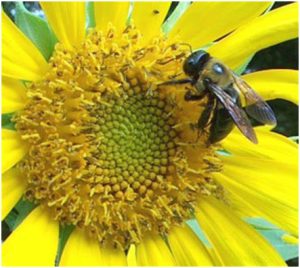Emmy Ulmschneider
Master Gardeners
If you have ever visited a garden in full bloom, maybe you noticed the vast array of different flower colors, sizes and shapes. And if you were quick enough to notice, you might have seen a variety of animals, birds, bees, butterflies, flies, beetles, wasps visiting the flowers. Perhaps you could see bees dusted with pollen or butterflies feeding on the nectar or smell the sweet smell of a blooming flower. Maybe at night you noticed an open flower with a large moth fluttering around it.
So, what is going on here?
As far as the plant is concerned, its job is to make seeds for more plants. And the way to more seeds is through pollination. Around 75 percent of pollination requires a pollinator to move the pollen from one part to another or from one plant to another. Pollinators and plants fit together like pieces of a puzzle. And over time plants and their pollinators have co-evolved many ways, from flower shape, size, blooming time and color. Nectar guides the right pollinator to them. And this collection of plant traits collectively are known as pollinator syndromes.
Plants pollinated by wind also have a specific set of traits. Gardeners can use this information to choose plants which will attract a certain kind of pollinator. Let’s consider three examples.
For instance, if you want to attract more hummers to your garden you want to look for scarlet, orange red or white flowers; odor is not important. Abundant nectar is deeply hidden in tubular or funnel shaped flowers funnel or cup-shaped flowers. It also helps if the plant has branches for perching.

If you are looking to attract our native bees or honeybees, a non-native species, look for plants with white, yellow, or blue flowers. These flowers usually have nectar, and the pollen is often sticky. The shape could vary from shallow to tubular and often the flower points to a landing area by its shape or color. In my garden, I look for native bees on sunflowers, gaillardia and just about any yellow composite.
Butterflies look for bright flowers including red and purple, the flowers often have a nectar guide, a colored pattern which points to the part of the flower where the nectar is. These guides may contain ultraviolet color patterns that insects can see but we cannot. Plants which attract butterflies often have a faint, fresh smell. In my yard, I find butterflies on Gregg’s Mistflower, sunflowers, and fall asters.
If you have ever walked outside early in the morning and smelled chocolate, that is not your nose deceiving you. Chocolate daisies are night bloomers and that delicate chocolate smell attracts the moths which are active night pollinators. By mid-morning, the flower is wilted and you will have to wait until the next night or early morning to get that intoxicating whiff.
So, want more life in your yard? Then plan for that by choosing plants that will attract the life you want!
For more information, call the AgriLife office at 498-4071 in Odessa or at 686-4700 in Midland or visit aggie-horticulture.tamu.edu or westtexasgardening.org.




